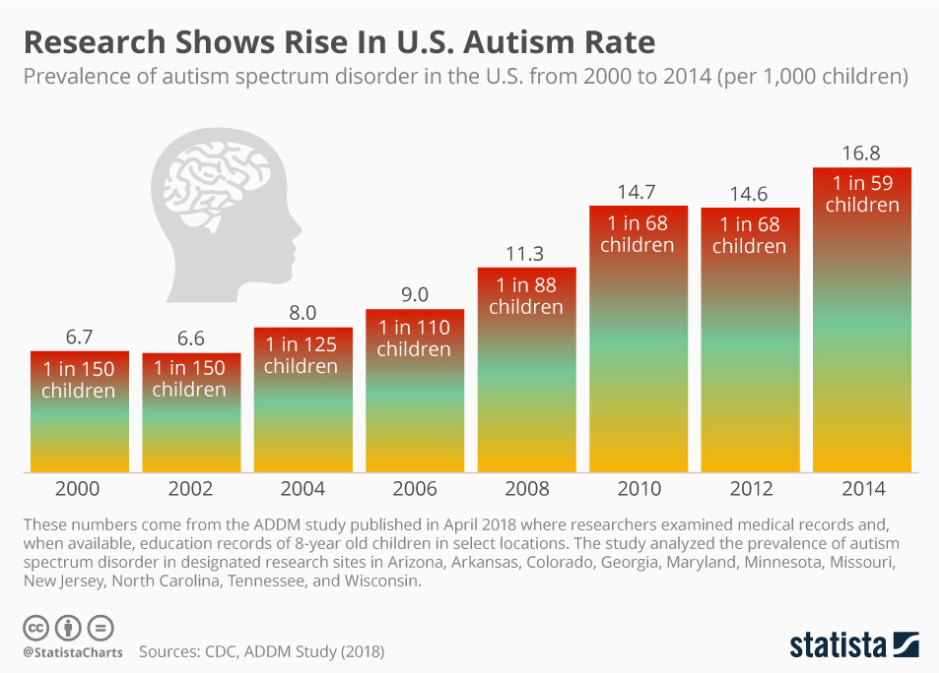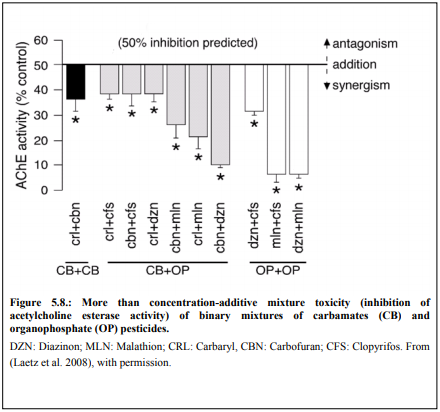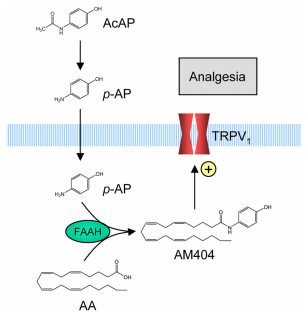|
Size: 9754
Comment:
|
Size: 9756
Comment:
|
| Deletions are marked like this. | Additions are marked like this. |
| Line 52: | Line 52: |
Itt írjon a(z) ED_autism_en-ról/ről
Endocrine Disruptors inducing Autism
Contents
Introduction
|
Figure 1 Rate of autism increase from 2000 to 2014 |
Plastics
Bisphenol A
Phthalates
Benzophenones
Insecticides and Herbicides
Organophosphates
Organophosphates are primarily used in insecticides and pesticides but are also the main component of nerve gas, used because of their neurotoxic effect. Since they can cross both the placenta and blood-brain barrier, they are associated with many developmental conditions (Adeyinka et Pierre, 2020). Organophosphates act as irreversible inhibitors of acetylcholinesterase, an enzyme that breaks down acetylcholine (ACh) into acetic acid and choline. Inhibition causes ACh to accumulate and disrupt synaptogenesis, axonogenesis and other neurological processes. Disruption of these processes is highlighted in the development of autism. Studies have also linked organophosphates to the down-regulation of serotonin receptors and to the dyshomeostasis of calcium and potassium (Philippat et al, 2018).
|
Figure 2 Acetlycholine Esterase inhibition by Organophosphates |
Chlorpyrifos, affects both the central and peripheral nervous system. It also inhibits acetylcholinesterase causing hyperstimulation of ACh receptors. It affects the transcription factors involved in neuron replication and differentiation, contributes to stunted axon growth and a thinning of the cerebral cortex. Gestational exposure shows significant links to lowered scores in the Mental and Psychomotor Development Index and greater incidence of attention deficits. It also lowers IQ scores and can impair memory. Chlorpyrifos exposure also more severely affects male children which is interesting given the sex difference associated with Autism (Lan et al, 2017).
Phytoestrogens
Soy contains high concentrations of the phytoestrogens Genistein which blocks thyroxine synthesis and tyrosine iodination. Thyroid hormones are important in neuron differentiation, synaptogenesis and axon myelination, all processes linked to autism development (Patisaul, 2016). Phytoestrogens also affect oestrogen receptors and oestrogen mediated pathways. Oestrogen receptors in the brain regulate apoptosis, synaptogenesis and neuronal differentiation. Estrogen is therefore very important in normal neuronal development (Sumien et al, 2013). There are two estrogen receptors in the body. Alpha receptors regulate the reproductive functions whereas beta receptors are involved in anxiety, memory and learning. Beta receptors are concentrated within the cortex and are bound by phytoestrogens.
Autism is linked to epilepsy in children. Recently soy-based foods have been shown to lower the seizure thresholds in children. The most well known genetic cause of Autism is Fragile X syndrome, an X-linked condition causing learning disabilities affecting males more severely than females (Westmark, 2014). It is believed that the effects of underlying genetic mutations and conditions that lower the seizure threshold (eg. Fragile X syndrome) may be enhanced by the ingestion of high concentrations of phytoestrogens (Westmark, 2014).
Autism affects boys five times more frequently than girls. In gestation, fetuses exposed to higher testosterone concentrations have an increased likelihood of developing autism because of the effect testosterones has on cognition. Aromatase is an important enzyme that irreversibly converts androgens (eg. testosterone) to estrogen. It is involved in neurogenesis, neuroprotection and the pathophysiology of autism spectrum disorders. Flavone and isoflavone phytoestrogens act as competitive inhibitors. They bind to the enzyme's active site, blocking the substrate's ability to bind. Phytoestrogens also act on a molecular level to decrease aromatase gene expression, preventing the enzymes production. With less aromatase synthesized, and the aromatase present inhibited, less testosterone is converted to estrogen. This could both affect the development of autism and partly account for gender imbalance (Lephart, 2015).
Triazoles and Fungicides
Pyrethroids
DDT
Heavy Metals
Thyroid hormones are crucial for the normal development of the nervous system, specifically for the myelination of neurons and synaptogenesis. Important in thyroid hormone synthesis are the deiodinase enzymes. These enzymes contain selenium and are involved in the activation and inactivation pathways of thyroid hormones. Their function is important in understanding the physiological effects of many heavy metals (Larsen et Zavacki, 2012).
Mercury bioaccumulates within food chains, its biomagnification means that apex predators have significantly raised levels in their tissues. People consuming these animals are therefore exposed to greater mercury levels. Mercury, often found as Methylmercury in the environment, interacts with selenium and chelates it forming mercury selenite. Mercury selenite accumulates in the brain having a neurotoxic effect on the organism. It also reduces the body's ability to make deiodinases and therefore it limits Thyroid hormone activation (Schonard, 2019).
Iodine is crucial for thyroid hormone synthesis and its largest dietary source comes from seafood. Therefore, coastal areas on average experience lower cases of iodine deficiency compared to landlocked areas who interestingly also experience raised autism rates. Low iodine levels among mothers limits thyroid hormone synthesis which indirectly leads to neurological development problems in their children. A study on pregnant mothers in Sicily showed this trend. It observed that women in mountainous regions had lower iodine levels compared to those living in coastal regions and that their children had average IQ scores 18 points lower than the children born to mothers with sufficient iodine. These children also had a greater prevalence of ADHD and Autism (Demeneix, 2017).
Other Heavy metals acting as EDCs include arsenic and lead. Children are more susceptible to Lead poisoning as a higher percentage of lead entering the gastrointestinal system can be absorbed into the bloodstream. They are therefore more susceptible to the damaging neurological effects of these metals (Baz et al, 2016). Children with autism are poor detoxifiers, It has been observed that autistic children have lower glutathione plasma levels. Glutathione is very important in the detoxification of heavy metals in the body and without sufficient levels, the effects of heavy metal exposure are worsened (Rubino, 2015).
Medicines and Pharmaceuticals
Diethlystilboestrol
Acetaminophen (Paracetamol)
|
Figure 3 The different structures involved in the analgesia phenomenon |
Acetaminophen, more commonly known as paracetamol, is one of the most frequented drugs worldwide providing pain and fever relief (Ramachandran et al, 2018). It is sought after for not being destructive to gastrointestinal or cardiorenal systems.
The mechanism of action is a result of its effect on cannabinoid CB1 receptors. CB1 receptors are found in brain areas that have been found to be significantly impaired in autism spectrum disorders. In the central nervous system, acetaminophen produces its relieving effect by forming N-arachidonoylphenolamine (AM404, an endogenous cannabinoid) from arachidonic acid and its primary amine, p-aminophenol. This process is catalysed by the enzyme fatty acid amide hydrolase (FAAH). N-arachidonoylphenolamine has the ability of preventing the re-uptake of anandamine by cells, leading to heightened levels of endocannabinoids (Bertolini et al, 2006). When there is no re-uptake of anandamide, there is increased activation of CB1 receptors and in this way the endocannabinoid system induces fever. Interestingly, fever has been linked with augmented sociability in children with ASD. Based on this evidence, it has been suggested that upon use of acetaminophen by young children, endocannabinoid stimulation is increased. This is then followed by more acetaminophen ingestion because the illness is prolonged due to a decrease in immunity. After recovery, the endocannabinoid system is diminished to make up for the over-stimulation and hence the child can develop ASD. (Schultz et al, 2016).
Prenatal Antidepressants
References
Figures
Figure 1: Research Shows Rise In Autism Rate. Statista. 2 April 2019. https://www.statista.com/chart/17578/autism-rate-in-the-united-states/
- Figure 2: Andreas Kortenkamp, Thomas Backhaus and Michael. Faust State of the Art Report on Mixture Toxicity. Final Report. Executive Summary. 22 December 2009. Study Contract Number 070307/2007/485103/ETU/D.1



